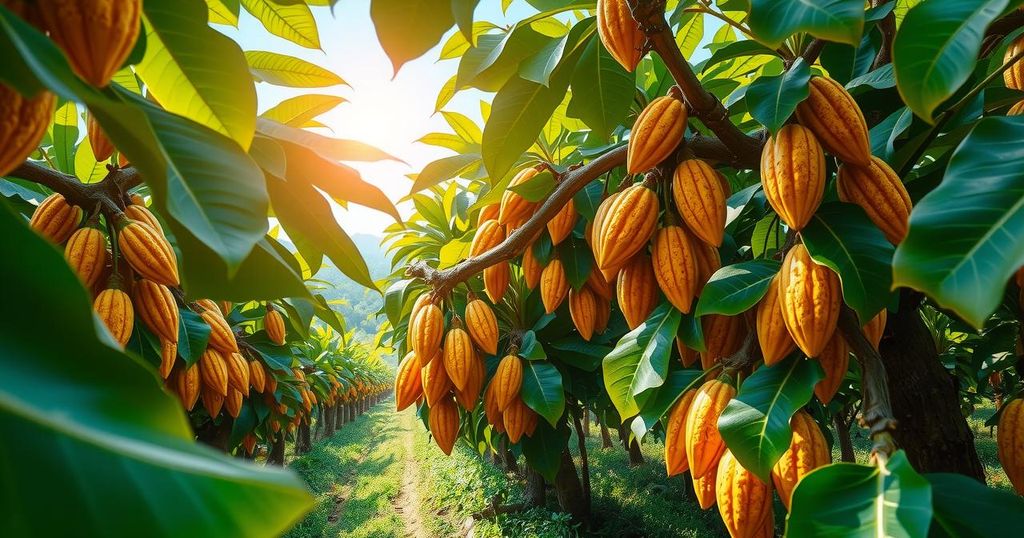Nigeria is focusing on expanding its cocoa production to compete with Ivory Coast and Ghana amidst soaring global prices, which reached $12,000 per tonne. With a target of 500,000 tonnes by 2024-2025, the government and local firms are investing in the sector. However, challenges exist, including reliance on small-scale farmers and environmental sustainability risks linked to monoculture practices.
Nigeria is aiming to capitalize on the rising cocoa prices, anticipating a significant expansion in its cocoa sector to compete with leading producers, Ivory Coast and Ghana. With global cocoa prices soaring to a record $12,000 per tonne, stakeholders are growing increasingly interested in Nigerian cocoa production. Patrick Adebola, the Executive Director at the Cocoa Research Institute of Nigeria, remarked, “The farmers have never had it so good.”
Recent interest from over a dozen local firms in expanding cocoa production underscores this trend. Additionally, the British government’s development finance institution has recently invested $40.5 million into Nigerian agribusiness firm Johnvents. Presently, Nigeria is reporting a cocoa production of over 280,000 tonnes for 2023, positioning itself as the seventh largest global producer according to the UN’s Food and Agriculture Organization.
The Nigerian government has set an ambitious production target of 500,000 tonnes for the 2024-2025 season, which would elevate the country to fourth place in global production rankings. While Adebola expresses skepticism about achieving this target immediately, he is optimistic that expanding interest in plantation rehabilitation and creation can yield results in the coming years. It is important to note that Nigerian cocoa growers are significantly affected by global market fluctuations, more so than their counterparts in regulated markets like Ivory Coast and Ghana.
Despite a drop from December’s record cocoa futures in New York, current prices remain elevated at over $8,000 per tonne, an impressive rise from the previous typical range of $2,000 to $3,000. Comrade Adeola Adegoke, President of the Cocoa Farmers Association of Nigeria, stated, “Individuals are going into cocoa production at every level… to make sure they also enjoy the current price.”
Ivory Coast remains the leading global cocoa producer, with over two million tonnes in 2023, while Ghana follows at 650,000 tonnes. Both countries faced adverse weather and crop diseases last year, resulting in supply shortages and high prices. In contrast, Nigeria’s cocoa production has largely avoided these climate-related issues, although expanded cultivation may pose environmental risks.
The government’s commitment to regulating the cocoa sector through the National Cocoa Management Committee, established in 2022, aims to support farmers and promote more sustainability in production methods. However, there are concerns regarding the promotion of “full-sun” monocrop plantations, which focus solely on cocoa cultivation and may adversely affect biodiversity and environmental health, as highlighted by a study in Agroforestry Systems.
Challenges also persist concerning the scale of cocoa farming, as most production occurs on small farms. Peter Okunde, a farmer from Ogun State, expressed frustrations over limited capital and land, stating, “Land is the major instrument farmers need… and the money to develop it.” Nonetheless, John Alamu, Managing Director of Johnvents, asserts that Nigeria’s cocoa framework is more robust than Ghana’s, noting the need for a comprehensive approach to farmer support, including the provision of quality seedlings and agronomic training, to restore Nigeria to its former leadership in cocoa production.
In summary, Nigeria is poised to expand its cocoa industry significantly, driven by soaring global prices and increased investment interest. While ambitious production targets have been set, challenges remain related to smallholder farming, land availability, and sustainable practices. Continuous government support and modernization efforts could ultimately position Nigeria as a competitive player in the global cocoa market, balancing economic growth with environmental considerations.
Original Source: www.iosconews.com




